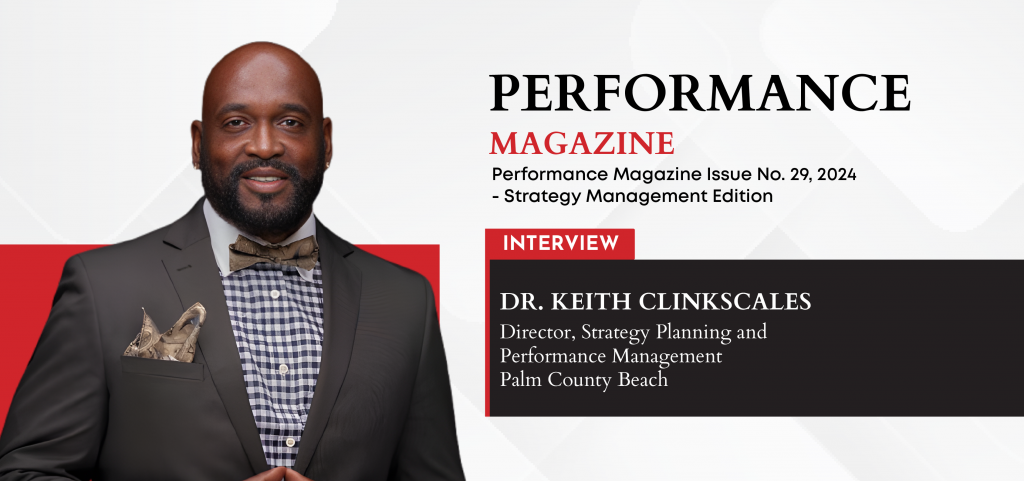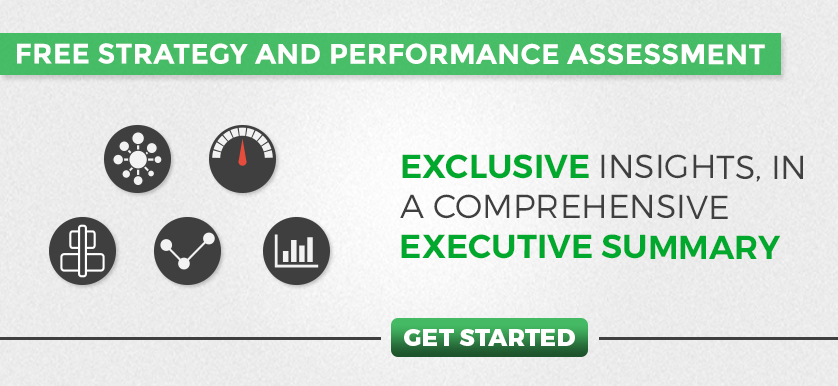Revisiting Success: What’s the Secret to Effective Cross-Departmental Strategies?

Dr. Keith Clinkscale was featured on the cover of Performance Magazine Issue No. 23, 2022 – Travel Edition, where he shared his passion for breaking barriers and rethinking silos between various departments in Palm Beach County. He discussed the Palm Beach County Strategic Planning and Performance Management Guide – Fiscal Year 2022/2023 and the valuable tools they utilized in their organization.
In 2024, Dr. Clinkscale returns for a follow-up interview to discuss their initiatives’ results and advancements in government strategy and performance management, highlighting innovation and the growing role of Artificial Intelligence (AI) in the government of the future.
We appreciated the insights you shared during your last interview with us. You mentioned then that cross-departmental teams were formed in accordance with the county’s new Six Strategic Priorities. Can you give an example of a successful project or any achievement that emerged from that move, and tell us about the results and key lessons learned?
One of our Six Strategic Priorities is Infrastructure. For context, Palm Beach is the largest county in the State of Florida. Due to the county’s vast size and complex infrastructure projects, the Infrastructure Cross-Department Team was formed to address coordination issues across over 15 departments with around 7000 employees. The team developed a GIS PORTAL application to allow departments to visualize ongoing projects and coordinate timelines. It was used to avoid extended traffic closures, consolidate costs, avoid unnecessary construction, and more. From a Strategic Planning and Performance Management aspect, this portal increased the efficiency of project coordination, eliminated resource waste, and prevented project reworking, leading to higher public satisfaction.
Continuous improvement and innovation seem central to your work. In light of these objectives, how is the rise of disruptive technologies such as AI impacting your strategy and performance management systems?
AI is becoming a frequent topic of conversation wherever I go. Many are still exploring its possibilities and how to leverage it effectively. There is mutual agreement that it is a viable and exciting new tool with many applications. For instance, we recently did a survey of over 7500 residents, with some questions allowing them to submit thoughts and recommendations, resulting in over 2000 written responses. AI was used to synthesize and summarize the responses and create common themes, which greatly complemented the survey results. Right now, I have seen the focus on educating the masses on AI and the many ways it can be used to enhance our work. I am very intrigued and look forward to incorporating it into performance management.
Read More >> AI Regulation: Different Regional Approaches and a Glimpse of the Future
Trends
What key trends do you think will influence the government sector in 2024 and the coming years?
To be honest, AI appears to be one trend that will dominate. It is a hot topic everywhere. Though still mysterious to many, it is constantly discussed and experimented with. AI can be applied in so many simple and complex ways, and the possibilities and challenges seem endless. So when asked about trends, all roads lead to AI.
The KPI Institute’s 2024 Global Trends Brief illuminates the interconnected nature of today’s challenges, from geopolitical shifts to technological disruptions. What initiatives or steps can governments take to ensure stakeholder alignment and commitment to strategic objectives?
The Voice of the Customer (VoC) is going to increase in importance. Engaging with and understanding what residents or stakeholders have to say must take precedence. People want to be heard and are demanding accountability. Governments must be willing to continue engagement surveys and town halls. This is scary to government entities because we are not always ready for abundant opinions, suggestions, and recommendations from the public. However, the data can be used to propel to greatness.
In transforming government employee career paths, what challenges could emerge during the shift from conventional, linear career progressions towards more adaptable avenues such as cross-departmental rotations and international secondments? How can these obstacles be effectively addressed?
I think the nature of government is the greatest threat to innovation. Most government employees are long-term employees who are accustomed to established procedures and may not always openly embrace innovative ideas and new ways of doing things. When people are limited to new technology and exposed to a culture resistant to change, transformation is virtually impossible.
What mechanisms can be put in place to ensure that AI-driven decision-making in government services upholds the principles of fairness, transparency, and accountability?
Well, to be honest, this is a million-dollar question. I do not think anyone knows— it is too early. AI is hitting the scene like Netflix taking over Blockbuster. Instead of avoiding and trying to control it, we need to embrace it and intentionally manage its inevitable role.
How can the government align its workforce capabilities and performance with the evolving demands of the AI revolution?
Well, most have Chief Information Officers (CIOs). However, in the future, there may need to be a Chief AI Officer because AI will take over how we do almost anything and everything. It needs to have its own center of excellence where AI practitioners work, develop, and learn from each other.
Read More >> Strategic Foresight and Planning: What’s Behind Singapore’s Adaptive Model?
Strategy and Performance Management Practices
What would you advise multilateral institutions to reach effectiveness and alignment in strategy planning and implementation?
My approach is to establish a one-page strategy that includes strategic priorities. But do not stop there because most fail at implementation. So, to build an operationalized strategy, I established high-performance cross-functional teams around each strategic priority and tasked the teams with implementing their respective strategic priority.
What are the key success factors for governments to build consistency in strategy and performance management?
As I said, the strategy needs to be broken down into strategic priorities. Each priority needs a team of the right folks focused on discussing, sharing, promoting, and managing all activities associated with that priority. Establishing dedicated teams drives engagement, inclusion, and implementation of each part of the strategy.
What are the most common pitfalls in strategy and performance management in governmental institutions? What can be learned from it?
The most common pitfalls are poor culture, engagement, and a lack of appreciation for strategy and performance measures. Culture is everything, and it will eat your strategy for breakfast. If the people are not collaborative, if they work in silos, and if they do not understand the importance of metrics, then they will passively resist.
What are the five characteristics of a high-performance government?
For me, the five characteristics of a high-performance government are (1) leadership and not management, (2) a thriving culture that is not toxic, (3) vision, (4) innovation, and (5) teams.
What is the key performance management tool used in your organization for decision-making? Is it the strategy plan, the strategy map, the balanced scorecard, or an executive dashboard?
The budget drives everything. However, we have been intentional about creating the vision, mission, core values, strategic priorities, and a scorecard metrics system. Now, all budget requests must be tied to a strategic priority and supported by metric data. Yet, sometimes the tendency is to make decisions without reviewing the metrics because it is just something that is needed. However, the ongoing goal is to tie everything to the metrics that justify it.
If you could convey the essence of government performance in three indicators, what would those be?
First is culture. I have realized that most governments have long-term employees who have never worked elsewhere. The world continues evolving, and many things can be done differently and more efficiently. However, unwillingness to change and fear of change can be significant barriers. So, creating a culture that is ready requires tons of training and change management.
Second, every department needs to have metrics that measure performance. Top leadership must emphasize and review these metrics, or the masses will not value them or see their importance.
Third, employee morale, engagement, and appreciation must be top of mind. People need to feel that they matter and are valued.
**********
Editor’s Note: This article was originally published in Performance Magazine Issue No. 30, 2024 – Government Edition.
About the Practitioner: Dr. Keith Clinkscale is the Director of Strategic Planning and Performance Management for Palm Beach County in the U.S. He supervises all activities related to the county’s long-term strategic plan and its over 30 departments. Furthermore, Dr. Keith is responsible for assisting the Board of County Commissioners (BCC), Executive Team, Department Directors, and staff with developing long-term goals, objectives, strategies, and actions.

Tags: cross-department, cross-departmental, cross-departmental strategy, high-performance government




